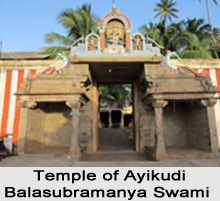 The Ayikudi Balasubramanya Swami Temple is located in Tirunelveli District in the Indian state of Tamil Nadu. It is a small Hindu temple situated in the village of Ayikudi.
The Ayikudi Balasubramanya Swami Temple is located in Tirunelveli District in the Indian state of Tamil Nadu. It is a small Hindu temple situated in the village of Ayikudi.
History of Ayikudi Balasubramanya Swami Temple
The region surrounding Ayikudi Balasubramanya Swami Temple remained under the Thiruvadhankur Kings until 1947. The temple of Ayikudi Balasubramanya Swami has been constructed on the banks of Hanuman Nadi. It is believed that Lord Hanuman had stayed on the banks of the river during his journey to Lanka. Hence, the river has been named as Hanuman Nadi. The deity of the temple was recovered from the Mallam River by a devotee, Mallan.
A Brahmin named Mugura Bhakthar once obtained samadhi in the temple region. In his memory a samadhi was constructed on the shoreline of Hanuman Nadi and an Arasa Tree was planted in that spot. The idol of Balasubramanya was also installed on the samadhi and devotees offered poojas and organised ceremonies there.
The upper portion of the temple was earlier built of coconut and palm leaves. Later the Thiruvadhankur Royal family took up the initiative to reconstructing and maintaining the temple. The temple was thus, rebuilt and celebration of several festivals were also initiated. The Balasubramanya Mulavar Pujas were performed by the sangethi Brahmins in a traditional way. The temple complex has five sacred tress believed to represent five different Gods such as Vembu neem (Ambhikai), Kariveppilai Curry leaves tree (Mahesha), Arasu (Lord Surya), Mavilangu (Lord Vishnu) and Madhulai (Lord Ganesha).
Idol of Ayikudi Balasubramanya Swami Temple
Lord Murugan of Ayikudi Balasubramanya Swami Temple is seated on a lotus flower and possesses four hands. The three hands illustrate shaktivaram, vajram and abhaya mudra while the fourth hand holds a peacock. Devotees visiting the temple offer Padi Payasam to the Lord. They also perform the famous Pallkudam dance in honour of the Lord.
The temple organises festivities for almost seven days during the Aipasi month i.e. from November 15th to December 15th. Every day the deity is decorated richly with a different look and taken out for a grand procession. Other than this several other festivals are also celebrated during Vaigasi Vishakam, Chithirai Vishu and Masi Makam. Pilgrims visiting the temple can also visit the Kutralam Falls, Kashi Vishwanathar Temple located in the vicinity of the temple.





















